Fabrication of Composites of Sodium Alginate with Guar Gum and Iron Coated Activated Alumina for the Purification of Water from Direct Blue 86
Abstract
:1. Introduction
2. Materials and Methods
2.1. Materials
2.2. Adsorbent Preparation
2.3. Characterization of Composites
2.4. Batch Experiment and Parameters Optimization
2.5. Adsorption Isotherms and Kinetics
3. Results and Discussion
3.1. Adsorbent Morphology and Structure
3.2. Paramers Optimization
3.3. Adsorption Isotherms
- Cad is the amount of specie adsorbed
- Ce is remaining concentration in solution after adsorption
- KF = relative adsorption capacity
- 1/n = adsorption intensity [35].
3.4. Kinetic Study
3.5. Adsorption Mechanism
3.6. Regeneration of Composites
4. Conclusions
Supplementary Materials
Author Contributions
Funding
Institutional Review Board Statement
Informed Consent Statement
Data Availability Statement
Acknowledgments
Conflicts of Interest
References
- Krishnappa, B.; Bhat, V.S.; Ancy, V.; Joshi, J.C.; Naik, M.; Hegde, G.J.M. Biowaste-Derived, Highly Efficient, Reusable Carbon Nanospheres for Speedy Removal of Organic Dyes from Aqueous Solutions. Molecules 2022, 27, 7017. [Google Scholar] [CrossRef] [PubMed]
- Tilt, B.J.H.O. Perceptions of risk from industrial pollution in China: A comparison of occupational groups. Human Organ. 2006, 65, 115–127. [Google Scholar] [CrossRef]
- Owa, F.D. Water pollution: Sources, effects, control and management. Mediterr. J. Soc. Sci. 2013, 4, 65. [Google Scholar] [CrossRef]
- Weiner, E.R. Applications of Environmental Chemistry: A Practical Guide for Environmental Professionals; CRC Press: Boca Raton, FL, USA, 2010. [Google Scholar]
- Khan, S.; Malik, A. Environmental and health effects of textile industry wastewater. In Environmental Deterioration and Human Health; Springer: Berlin/Heidelberg, Germany, 2014; pp. 55–71. [Google Scholar]
- Kant, R. Textile dyeing industry an environmental hazard. J. Nat. Sci. 2012, 4, 22–26. [Google Scholar] [CrossRef] [Green Version]
- El Nemr, A.; Abdelwahab, O.; El-Sikaily, A.; Khaled, A. Removal of direct blue-86 from aqueous solution by new activated carbon developed from orange peel. J. Hazard. Mater. 2009, 161, 102–110. [Google Scholar] [CrossRef]
- Gita, S.; Hussan, A.; Choudhury, T.J.E.E. Impact of textile dyes waste on aquatic environments and its treatment. Environ. Ecol. 2017, 35, 2349–2353. [Google Scholar]
- Padma, G.T.; Rao, T.S.; Naidu, K.C.B. Preparation, characterization and dielectric properties of sodium alginate/titanium dioxide composite membranes. SN Appl. Sci. 2018, 1, 75. [Google Scholar] [CrossRef] [Green Version]
- Verma, A.; Thakur, S.; Mamba, G.; Gupta, R.K.; Thakur, P.; Thakur, V.K. Graphite modified sodium alginate hydrogel composite for efficient removal of malachite green dye. Int. J. Biol. Macromol. 2020, 148, 1130–1139. [Google Scholar] [CrossRef]
- Zhao, X.; Wang, X.; Lou, T. Preparation of fibrous chitosan/sodium alginate composite foams for the adsorption of cationic and anionic dyes. J. Hazard. Mater. 2021, 403, 124054. [Google Scholar] [CrossRef]
- Racoviţă, S.; Vasiliu, S.; Popa, M.; Luca, C. Polysaccharides based on micro-and nanoparticles obtained by ionic gelation and their applications as drug delivery systems. Rev. Roum. De Chim. 2009, 54, 709–718. [Google Scholar]
- Shahid, M.; Bukhari, S.A.; Gul, Y.; Munir, H.; Anjum, F.; Zuber, M.; Jamil, T.; Zia, K.M. Graft polymerization of guar gum with acryl amide irradiated by microwaves for colonic drug delivery. Int. J. Biol. Macromol. 2013, 62, 172–179. [Google Scholar] [CrossRef]
- Zhong, Z.Y.; Prozorov, T.; Felner, I.; Gedanken, A. Sonochemical Synthesis and Characterization of Iron Oxide Coated on Submicrospherical Alumina: A Direct Observation of Interaction between Iron Oxide and Alumina. J. Phys. Chem. B 1999, 103, 947–956. [Google Scholar] [CrossRef]
- Kim, S.-G.; Lim, G.-T.; Jegal, J.; Lee, K.-H. Pervaporation separation of MTBE (methyl tert-butyl ether) and methanol mixtures through polyion complex composite membranes consisting of sodium alginate/chitosan. J. Membr. Sci. 2000, 174, 1–15. [Google Scholar] [CrossRef]
- Ionita, M.; Pandele, M.A.; Iovu, H. Sodium alginate/graphene oxide composite films with enhanced thermal and mechanical properties. Carbohydr. Polym. 2013, 94, 339–344. [Google Scholar] [CrossRef]
- Roger, S.; Bee, A.; Balnois, E.; Bourmaud, A.; Le Deit, H.; Grohens, Y. Physical and Mechanical Properties of Alginate Films Containing Calcium Cations and Ferrofluids. In Proceedings of the 5th International Conference on Polymer-Solvent Complexes & Intercalates, Lorient, France, 11–13 July 2004. [Google Scholar]
- Shaari, N.; Kamarudin, S.J.P.T. Sodium alginate/alumina composite biomembrane preparation and performance in DMFC application. Polym. Test. 2020, 81, 106183. [Google Scholar] [CrossRef]
- Kumar, A.; De, A.; Mozumdar, S. Synthesis of acrylate guar-gum for delivery of bio-active molecules. Bull. Mater. Sci. 2015, 38, 1025–1032. [Google Scholar] [CrossRef]
- Kuo, C.-Y.; Wu, C.-H.; Wu, J.-Y. Adsorption of direct dyes from aqueous solutions by carbon nanotubes: Determination of equilibrium, kinetics and thermodynamics parameters. J. Colloid Interface Sci. 2008, 327, 308–315. [Google Scholar] [CrossRef]
- Parveen, S.; Rana, S.; Fangueiro, R. A review on nanomaterial dispersion, microstructure, and mechanical properties of carbon nanotube and nanofiber reinforced cementitious composites. J. Nanomater. 2013, 2013, 1–19. [Google Scholar] [CrossRef]
- Alsharef, J.M.; Taha, M.R.; Khan, T.A. Physical dispersion of nanocarbons in composites–a review. J. Teknol. 2017, 79, 5. [Google Scholar] [CrossRef] [Green Version]
- Caon, T.; Zanetti-Ramos, B.G.; Lemos-Senna, E.; Cloutet, E.; Cramail, H.; Borsali, R.; Soldi, V.; Simoes, C.M.O. Evaluation of DNA damage and cytotoxicity of polyurethane-based nano-and microparticles as promising biomaterials for drug delivery systems. J. Nanoparticle Res. 2010, 12, 1655–1665. [Google Scholar] [CrossRef]
- Bhargava, S.; Chu, J.J.H.; Valiyaveettil, S. Controlled Dye Aggregation in Sodium Dodecylsulfate-Stabilized Poly(methylmethacrylate) Nanoparticles as Fluorescent Imaging Probes. ACS Omega 2018, 3, 7663–7672. [Google Scholar] [CrossRef] [PubMed] [Green Version]
- Mahajan, A.; Ramana, E.V. Patents on magnetoelectric multiferroics and their processing by electrophoretic deposition. In Recent Patents on Materials Science; Bentham Science Publishers: Sherga, United Arab Emirates, 2014; Volume 7, pp. 109–130. [Google Scholar]
- Clogston, J.D.; Patri, A.K. Zeta Potential Measurement. Characterization of Nanoparticles Intended for Drug Delivery; Springer: Berlin/Heidelberg, Germany, 2011; pp. 63–70. [Google Scholar]
- Garg, D.; Majumder, C.; Kumar, S.; Sarkar, B.J. Removal of Direct Blue-86 dye from aqueous solution using alginate encapsulated activated carbon (PnsAC-alginate) prepared from waste peanut shell. J. Environ. Chem. Eng. 2019, 7, 103365. [Google Scholar] [CrossRef]
- Topuz, B.B.; Gündüz, G.; Mavis, B.; Çolak, Ü.J.D. Pigments, Synthesis and characterization of copper phthalocyanine and tetracarboxamide copper phthalocyanine deposited mica-titania pigments. Dye. Pigment. 2013, 96, 31–37. [Google Scholar] [CrossRef]
- Magisetty, R.; Prajapati, D.; Ambekar, R.; Shukla, A.; Kandasubramanian, B. β-Phase Cu-phthalocyanine/acrylonitrile butadiene styrene terpolymer nanocomposite film technology for organoelectronic applications. J. Phys. Chem. C 2019, 123, 28081–28092. [Google Scholar] [CrossRef]
- Athanasiu, A.A.; Deaconu, M.; Crudu, M.; Doncea, S.; Stoica, R.; Oproiu, L.; Senin, R.; Ruse, M.; Rosu, D.; Filipescu, C. Synthesis and Characterization of Nanosized Copper (II)-Phthalocyanine Pigment (P BI 15: 3) with the Modified Surface. I. Rev. De Chim. 2017, 68, 343–349. [Google Scholar] [CrossRef]
- Nauka, K.; Zhao, Y.; Ng, H.-T.; Hanson, E.G. Surface Molecular Vibrations as a Tool for Analyzing Surface Impurities in Copper Phthalocyanine Organic Nanocrystals. MRS Proc. 2010, 1270, 659. [Google Scholar] [CrossRef]
- Eshkalak, S.K.; Khatibzadeh, M.; Kowsari, E.; Chinnappan, A.; Ramakrishna, S. Pigments, A novel surface modification of copper (II) phthalocyanine with ionic liquids as electronic ink. Dye. Pigment. 2018, 154, 296–302. [Google Scholar] [CrossRef]
- Mourabet, M.; El Boujaady, H.; El Rhilassi, A.; Ramdane, H.; Bennani-Ziatni, M.; El Hamri, R.; Taitai, A. Defluoridation of water using Brushite: Equilibrium, kinetic and thermodynamic studies. Desalination 2011, 278, 1–9. [Google Scholar] [CrossRef]
- Priyantha, N.; Lim, L.; Dahri, M.K.; Tennakoon, D.T.B. Dragon Fruit Skin as a Potential Low-Cost Biosorbent for the Removal of Manganese(II) Ions. J. Appl. Sci. Environ. Sanit. 2013, 8, 179–188. [Google Scholar]
- Dada, A.O.; Olalekan, A.P.; Olatunya, A.M.; Dada, O. Langmuir, Freundlich, Temkin and Dubinin–Radushkevich isotherms studies of equilibrium sorption of Zn2+ unto phosphoric acid modified rice husk. IOSR J. Appl. Chem. 2012, 3, 38–45. [Google Scholar]
- López-Luna, J.; Ramírez-Montes, L.E.; Martinez-Vargas, S.; Martínez, A.I.; Mijangos-Ricardez, O.F.; González-Chávez, M.d.C.A.; Carrillo-González, R.; Solís-Domínguez, F.A.; Cuevas-Díaz, M.d.C.; Vázquez-Hipólito, V. Linear and nonlinear kinetic and isotherm adsorption models for arsenic removal by manganese ferrite nanoparticles. Appl. Sci. 2019, 1, 950. [Google Scholar] [CrossRef] [Green Version]
- Karthik, V.; Selvakumar, P.; Sivarajasekar, N.; Megavarshini, P.; Brinda, N.; Kiruthika, J.; Balasubramani, K.; Ahamad, T.; Naushad, M. Comparative and Equilibrium Studies on Anionic and Cationic Dyes Removal by Nano-Alumina-Doped Catechol Formaldehyde Composite. J. Chem. 2020, 2020, 7617989. [Google Scholar] [CrossRef]
- Benmessaoud, A.; Nibou, D.; Mekatel, E.H.; Amokrane, S.; Engineering, C. A comparative study of the linear and non-linear methods for determination of the optimum equilibrium isotherm for adsorption of Pb2+ ions onto Algerian treated clay. Iran. J. Chem. Chem. 2020, 39, 153–171. [Google Scholar]
- Al-Ma’abreh, A.M.; Abuassaf, R.A.; Hmedat, D.A.; Alkhabbas, M.; Edris, G.; Hussein-Al-Ali, S.H.; Alawaideh, S. Adsorption Characteristics of Hair Dyes Removal from Aqueous Solution onto Oak Cupules Powder Coated with ZnO. Int. J. Mol. Sci. 2022, 23, 11959. [Google Scholar] [CrossRef]
- Ghaffari, H.R.; Pasalari, H.; Tajvar, A.; Dindarloo, K.; Goudarzi, B.; Alipour, V.; Ghanbarneajd, A. Linear and nonlinear two-parameter adsorption isotherm modeling: A case-study. Int. J. Eng. Sci. 2017, 6, 1–11. [Google Scholar]
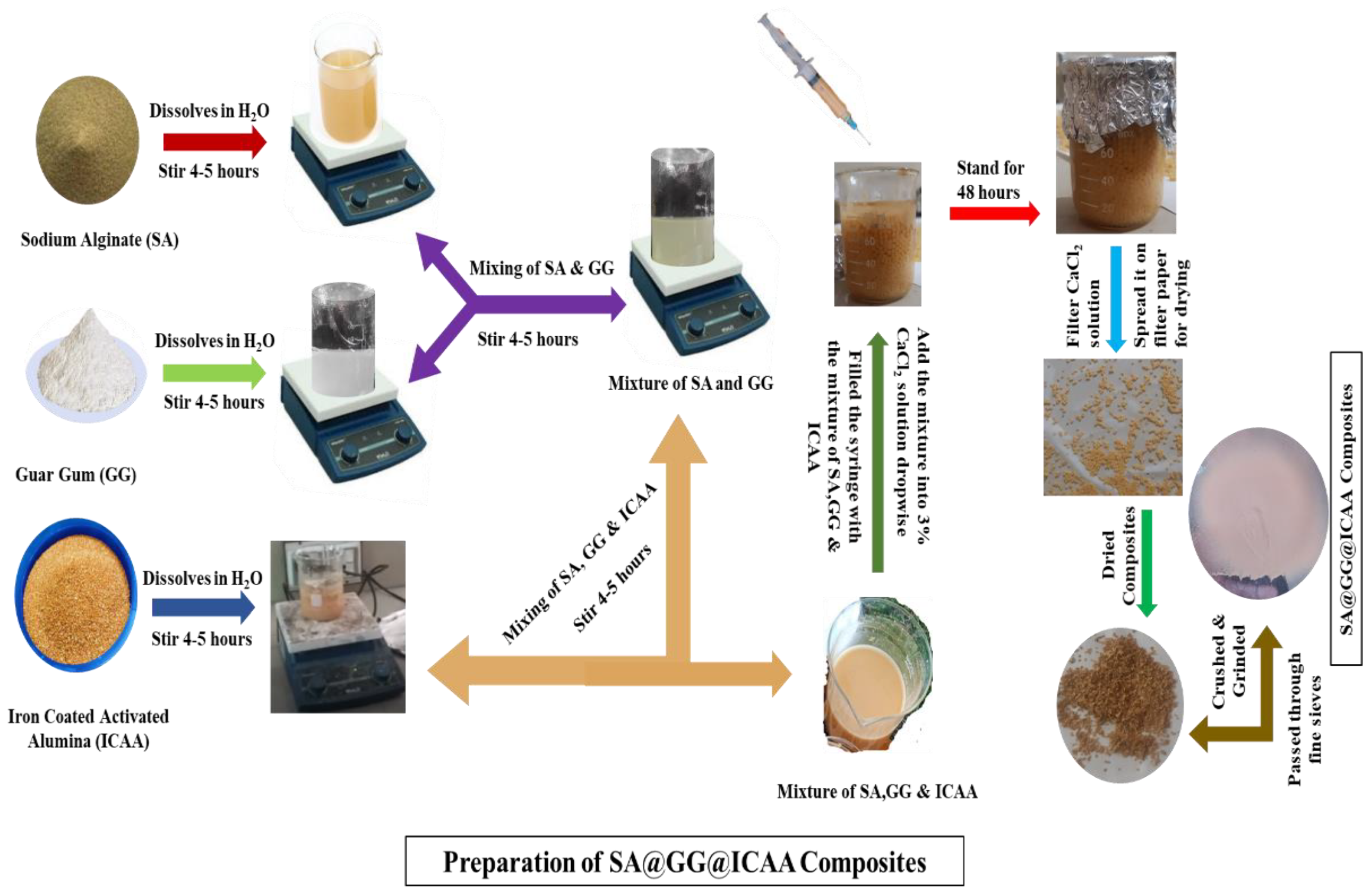
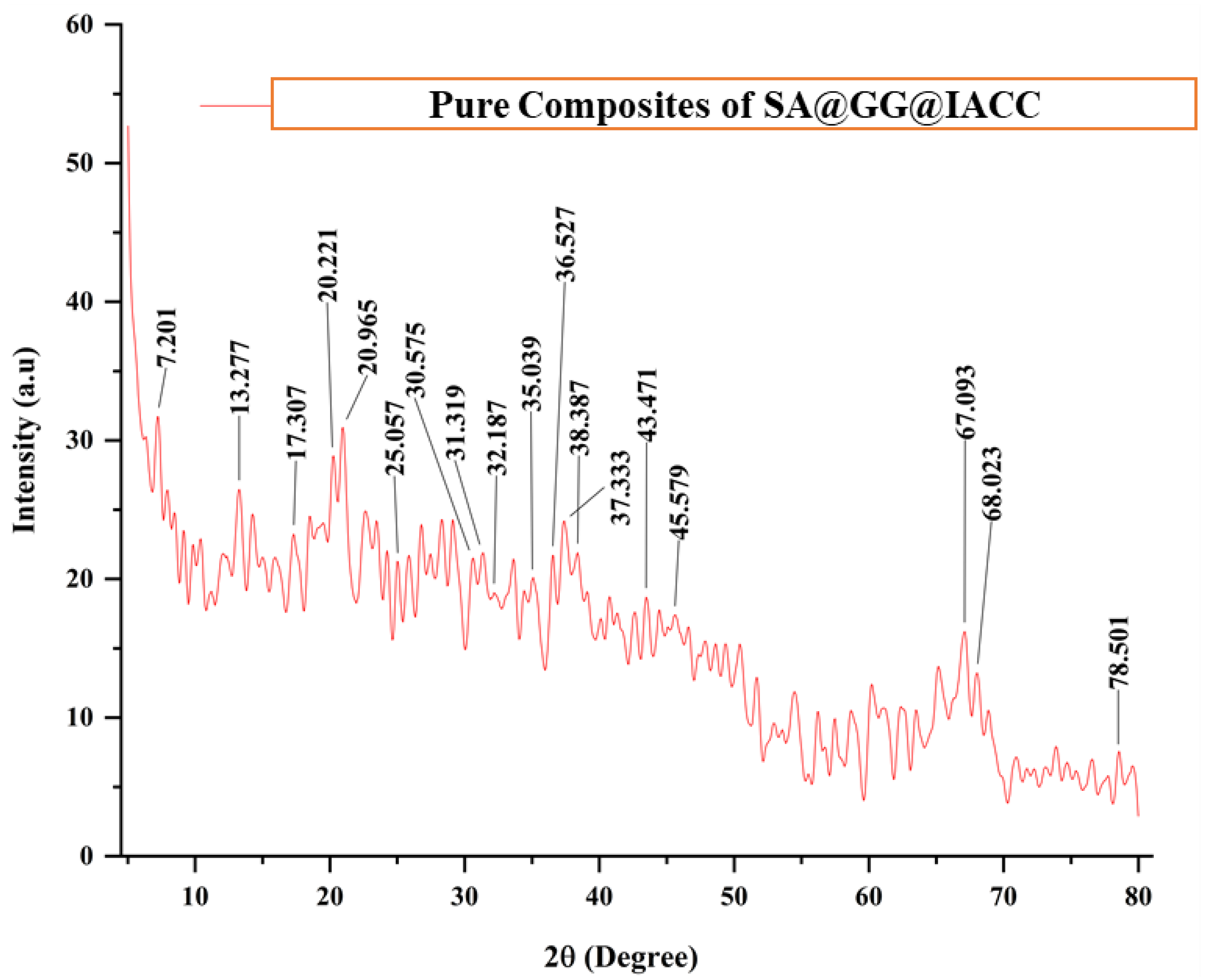
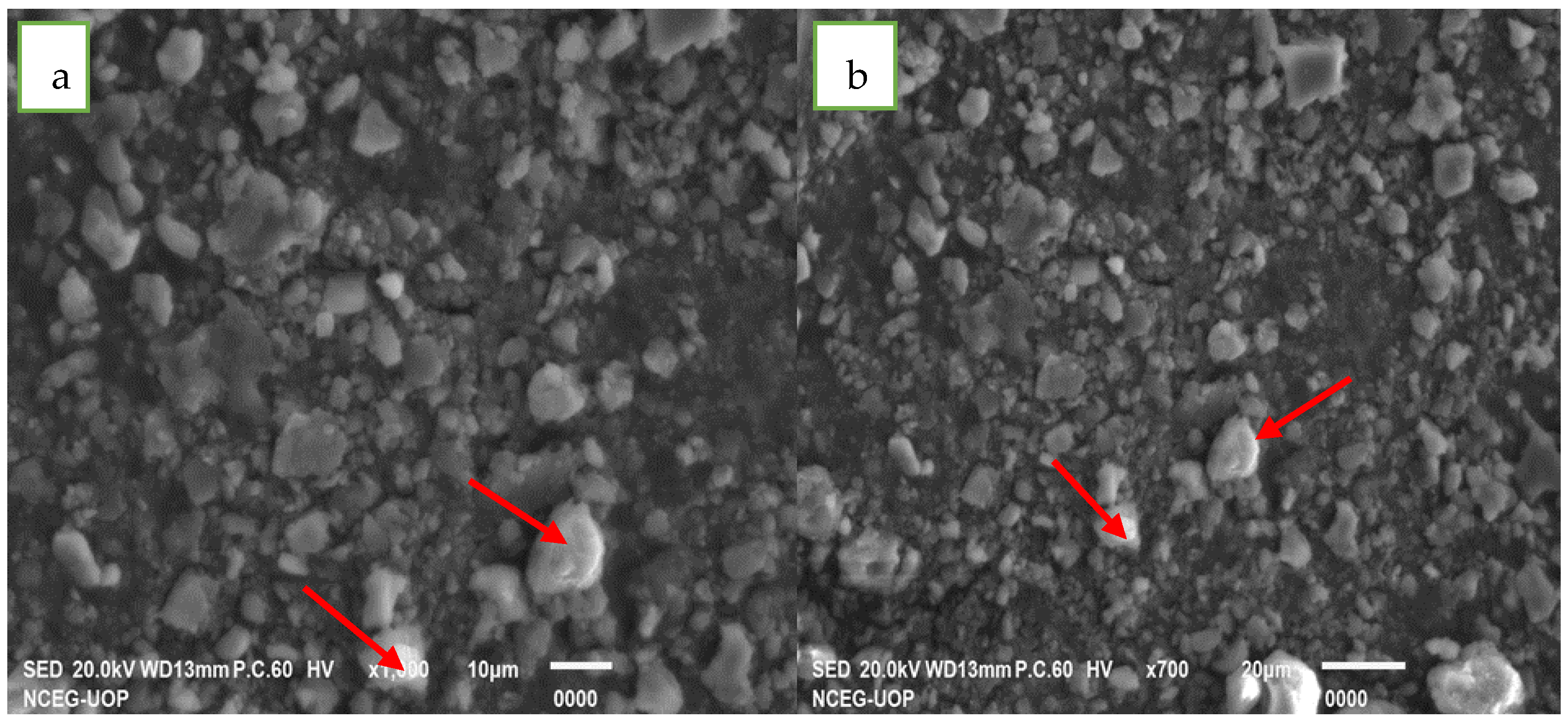

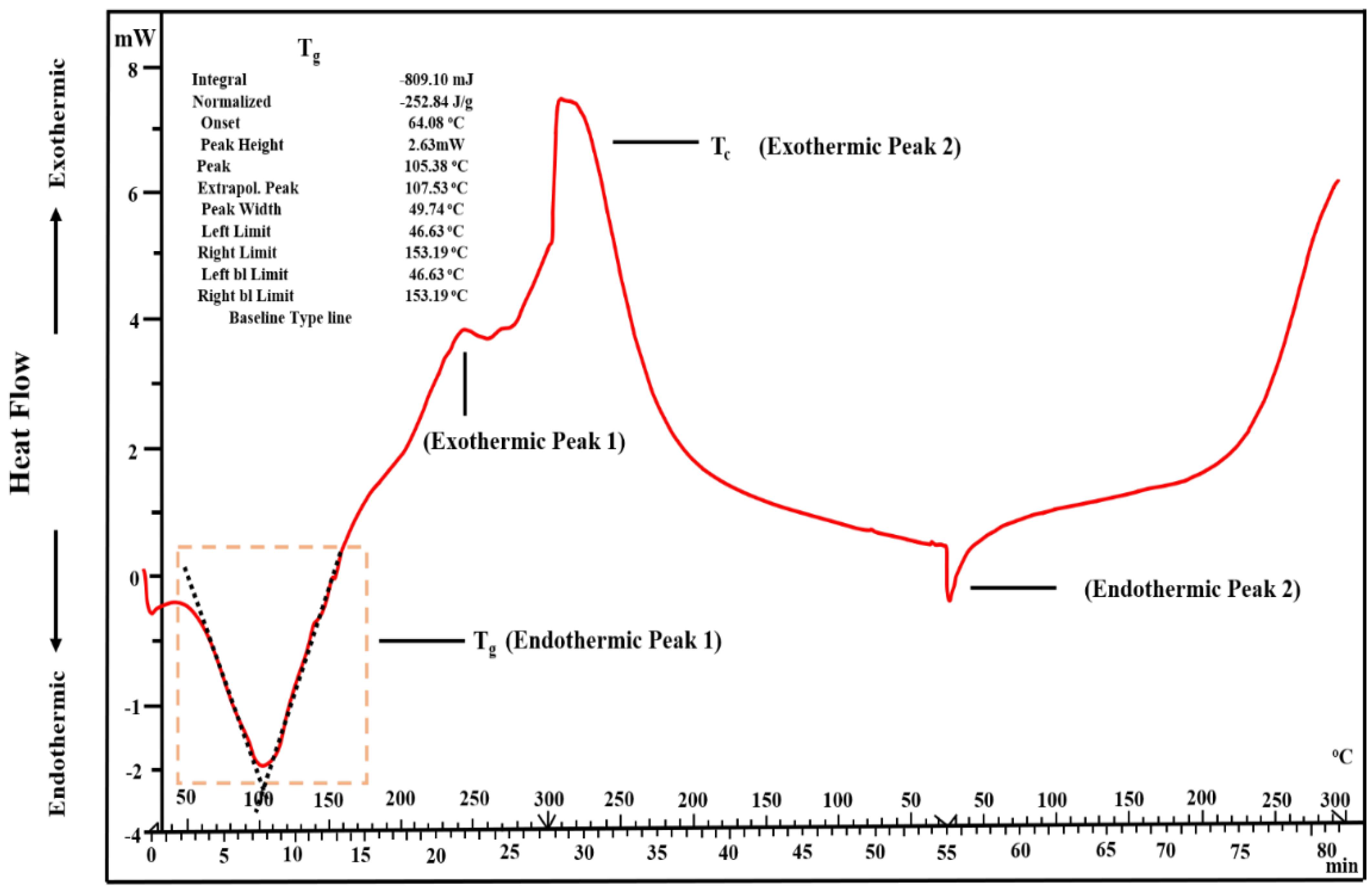


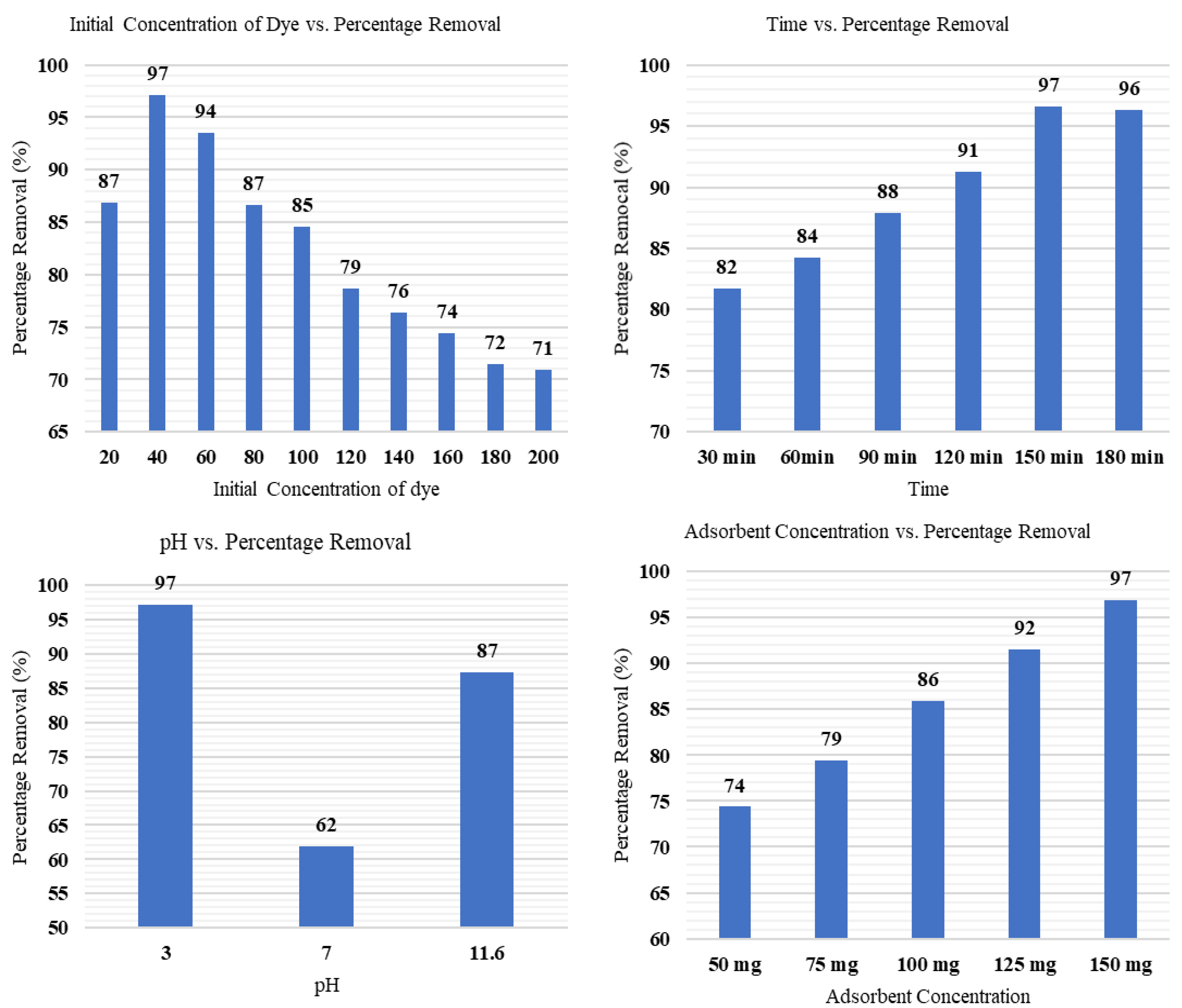

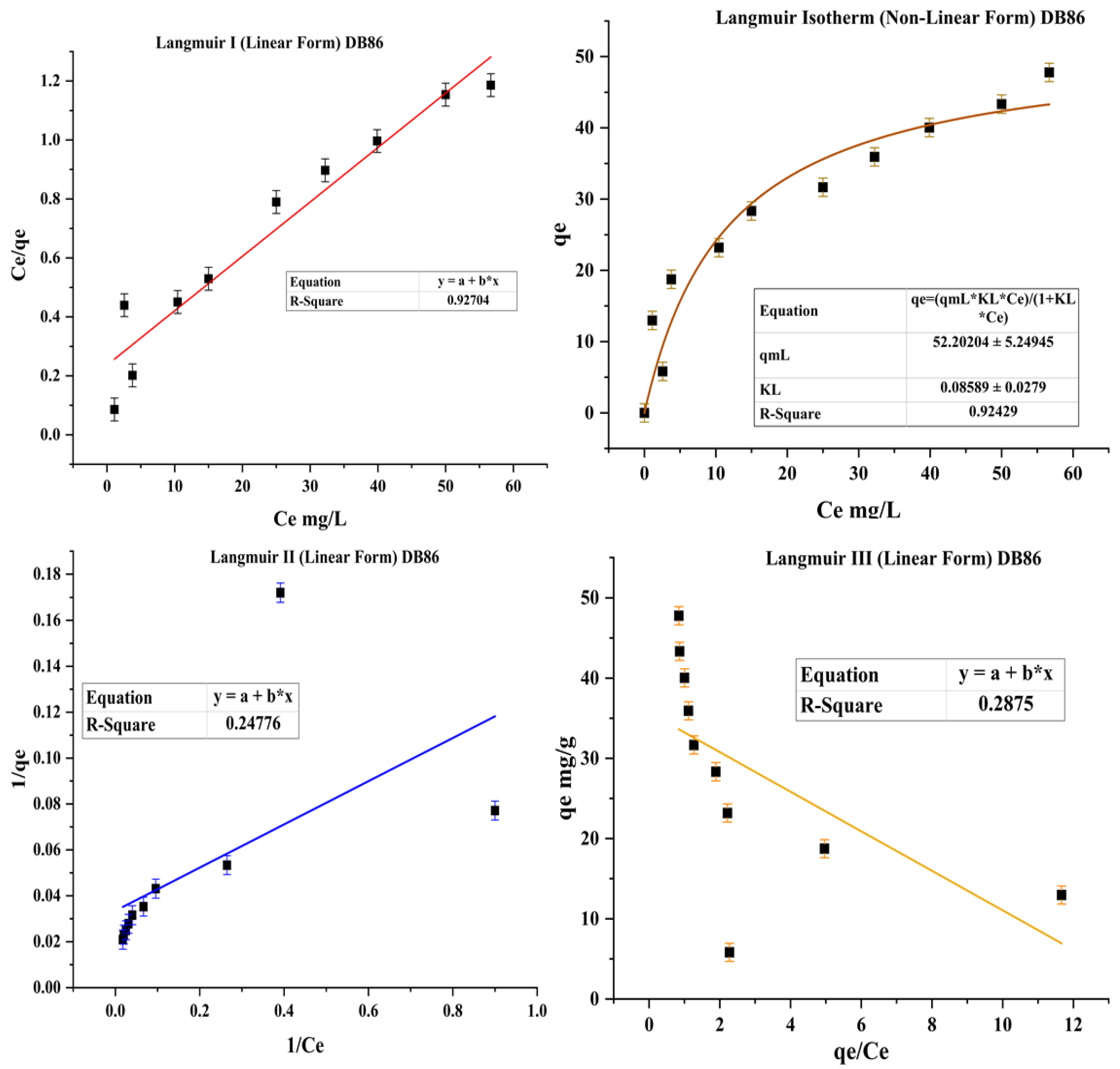

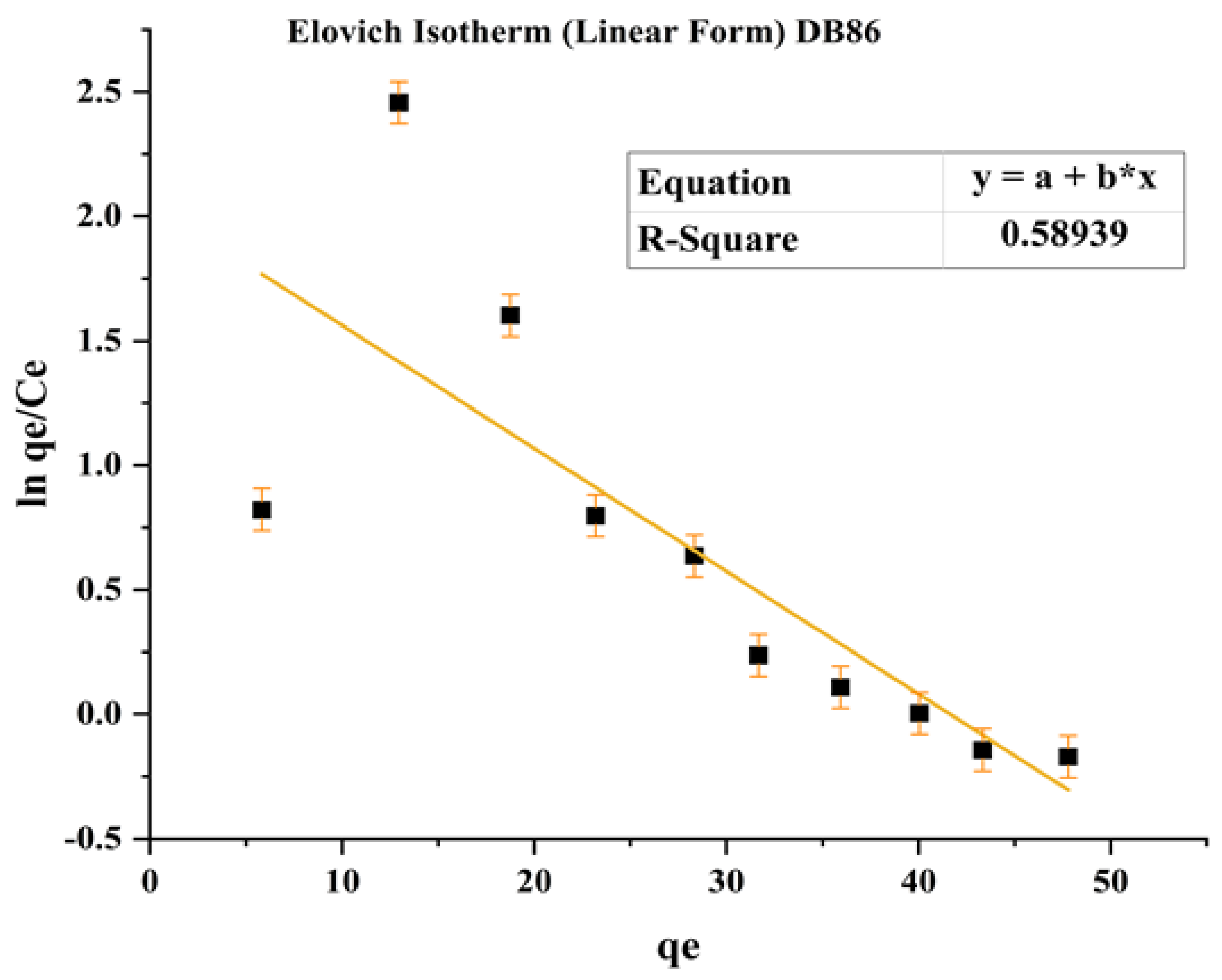
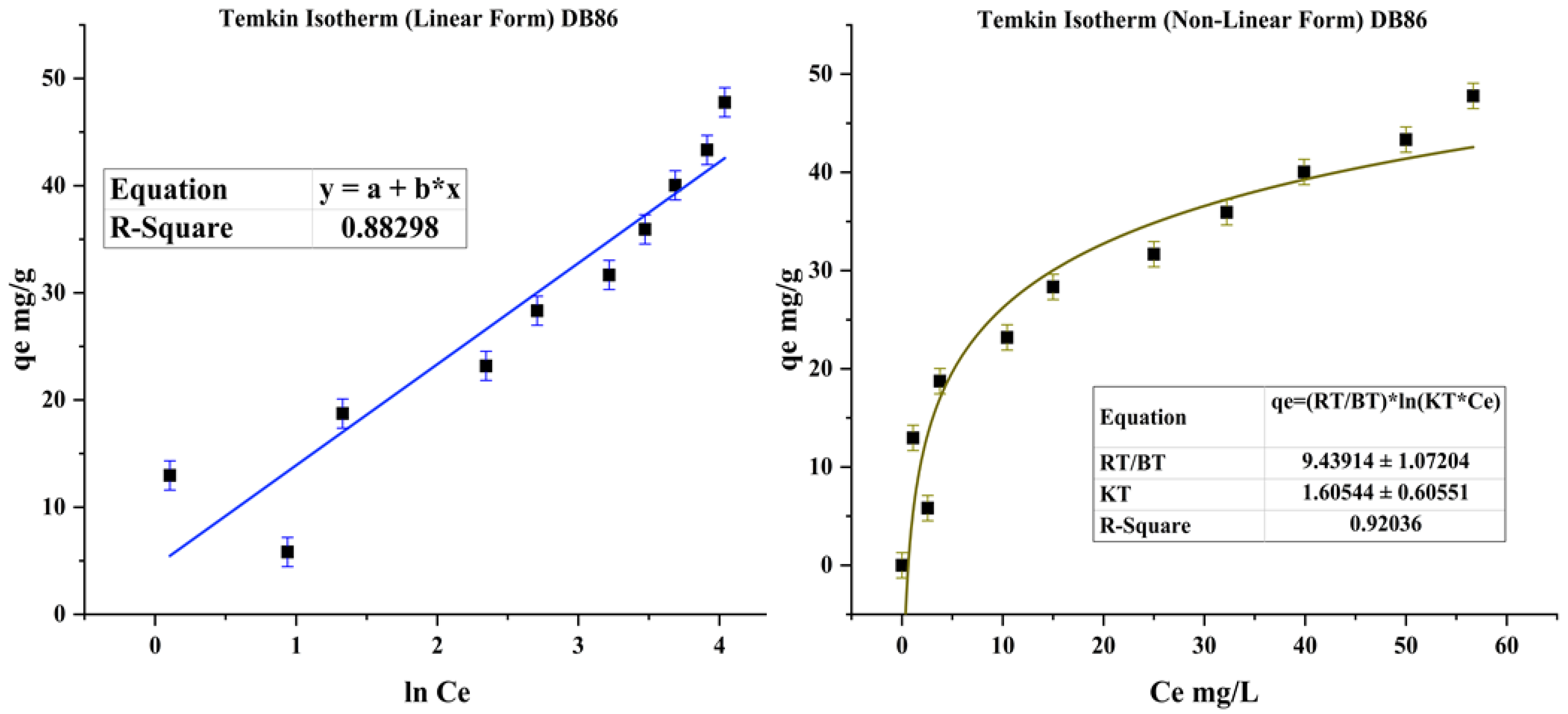
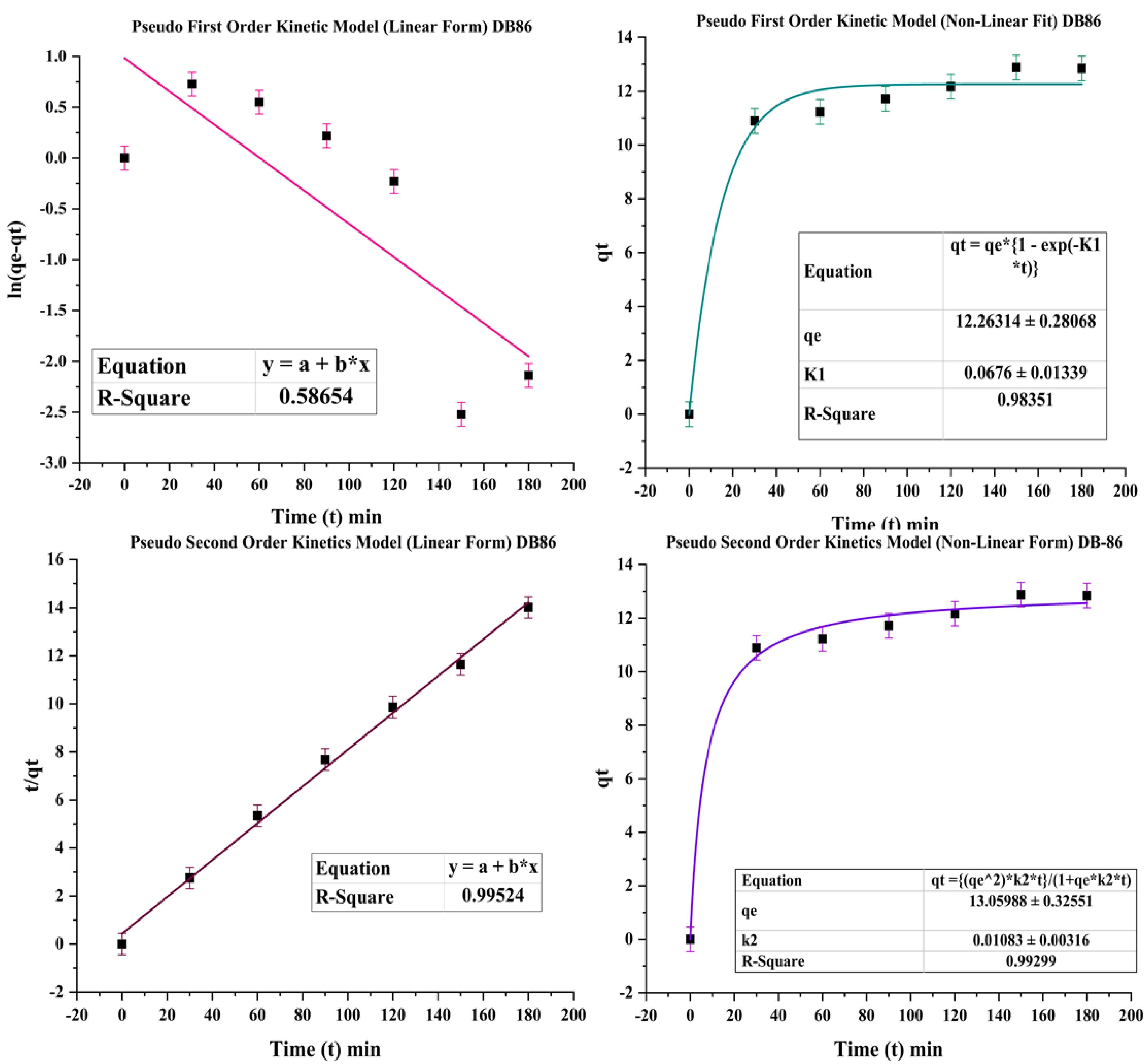

Disclaimer/Publisher’s Note: The statements, opinions and data contained in all publications are solely those of the individual author(s) and contributor(s) and not of MDPI and/or the editor(s). MDPI and/or the editor(s) disclaim responsibility for any injury to people or property resulting from any ideas, methods, instructions or products referred to in the content. |
© 2023 by the authors. Licensee MDPI, Basel, Switzerland. This article is an open access article distributed under the terms and conditions of the Creative Commons Attribution (CC BY) license (https://creativecommons.org/licenses/by/4.0/).
Share and Cite
Kanwal, S.; Irfan, A.; Al-Hussain, S.A.; Sharif, G.; Mumtaz, A.; Batool, F.; Zaki, M.E.A. Fabrication of Composites of Sodium Alginate with Guar Gum and Iron Coated Activated Alumina for the Purification of Water from Direct Blue 86. Coatings 2023, 13, 103. https://doi.org/10.3390/coatings13010103
Kanwal S, Irfan A, Al-Hussain SA, Sharif G, Mumtaz A, Batool F, Zaki MEA. Fabrication of Composites of Sodium Alginate with Guar Gum and Iron Coated Activated Alumina for the Purification of Water from Direct Blue 86. Coatings. 2023; 13(1):103. https://doi.org/10.3390/coatings13010103
Chicago/Turabian StyleKanwal, Samia, Ali Irfan, Sami A. Al-Hussain, Gulnaz Sharif, Amina Mumtaz, Fozia Batool, and Magdi E. A. Zaki. 2023. "Fabrication of Composites of Sodium Alginate with Guar Gum and Iron Coated Activated Alumina for the Purification of Water from Direct Blue 86" Coatings 13, no. 1: 103. https://doi.org/10.3390/coatings13010103
APA StyleKanwal, S., Irfan, A., Al-Hussain, S. A., Sharif, G., Mumtaz, A., Batool, F., & Zaki, M. E. A. (2023). Fabrication of Composites of Sodium Alginate with Guar Gum and Iron Coated Activated Alumina for the Purification of Water from Direct Blue 86. Coatings, 13(1), 103. https://doi.org/10.3390/coatings13010103








